Editor’s Note:
The study of the spread of civilizations and the formation of different cultures is a scientific and scholarly work. Since the writer of this article is a student of Anthropology, Political Philosophy, and History but not a learned social scientist, therefore, the writer in this article raises only some questions, possibilities, probabilities, and challenges that can be answered by historians.
By Agha Iqrar Haroon
History is not a stagnant science rather it is documentation of flow of events but sometimes History is left unchanged and stagnant for certain reasons. One of the reasons is that major stakeholders of History do not challenge unchanged and stagnant chapters of History. The same story is with usage of the terminology of “Indo-Aryan” for last 73 years by students of History, Anthropology and Archology.
After the division of Hindustan or so-called Subcontinent in 1947, the terminology of “Indo” represents only the modern state of India.
The definition of “Indo” was used for areas of “Subcontinent” in history during the British Empire between 1857 to 1947 but it seized to work after British India was divided into modern Pakistan and the modern state of India.
Interestingly, there was no word “India” (or “Indo”) exists in History before the British Empire started calling the newly invaded subcontinent as “India” around 1840/1857. The word India was coined by British Raj for representing culture, history, and areas under the rule of newly formed “Crown Rule in India“.
Before British Raj in Subcontinent, regions comprising today’s India, Pakistan and Bangladesh were called Hindustan or BAR-E-SAGHIR (برصغیر) that means “Subcontinent”.
After 1947, the region was divided into India and Pakistan and Bangladesh became into being after the further division of East Pakistan from West Pakistan after Indo-Pakistan 1971 war. Therefore, there was no “Indo” before 1857 and after 1947 while Aryan came in this land thousands of years ago. The invasion of Aryan or Europe in the region of Subcontinent was in those areas which had always been part of modern Pakistan not of modern India.
Modern Pakistan has been the cradle of all old civilizations founds in Subcontinent/South Asia but unfortunately, these Civilisations are known as Indo-European in history books instead of Pak-European because there was no Pakistan and subcontinent (today’s India, Pakistan, Bangladesh) was known as India for European writers, foreign archeologists and historians till 1947.
After 1947, writers, historians, and archeologists should have rephrased Indo-European into Pak-European but this was never done.
Calling Harappa and Mohenjo-Daro or Indus Valley civilizations as “Indo-European” is a similar fallacy if someone calling Ottoman Queen Huram Sultan as a citizen of Russian Empire or citizen of former the Soviet Union instead of a Ukrainian or Austro-Hungarian citizen because the era of Huram Sultan was far before the formation of Russian Empire and formation of former the Soviet Union.
To understand this point that why historical and archeological data known as “Indo-European” should be called “Pak-European” after the year 1947, one should look into the factsheet of geographical presence of all archeological remains and historical sites related to so-called “Indo-European” or “Indo-Aryan”.
All geographical points (archeological sites) are actually located, situated, and rooted in today’s Pakistan. All archeological remains of Indus Valley Civilization are also in modern Pakistan not in modern India.
One of the oldest sites of human dwelling is “Mehrgarh” which is a Neolithic site (dated c. 7000 BCE to c. 2500/2000 BCE). This lies in the Kacchi Plain of Balochistan, Pakistan.
Mohenjo-Daro (date back to around 2500 BCE) lies in Sindh Pakistan, Kot Diji (Built around 3300–2600 BCE) also lies Sindh Pakistan, Harappa (date back 2600 BCE) lies in Punjab Pakistan), Hakra River Civilisation (3800 BCE) lies in Bahawalpur Punjab Pakistan) and Gandhara civilizations (550-530 BCE) lies in Swat (KPK) and Taxila Punjab Pakistan.
Pakistan came into being in 1947 but no work has been done so far to rephrase Indo-European to “Pak-European” Civilisations.
The terminology of Indo-Aryan Migration must also be changed as “Pak-Aryan Migration” because Aryan entered into modern Pakistan either from modern Afghanistan or from modern Iran and then moved away from River Indus towards River Ganga and Jumna after settling down for hundreds of years in regions which are part of modern Pakistan.
There is another fallacy that civilizations of modern Pakistan (Mohenjo-Daro, Kot Dijian, Harappan, and Hakra River Civilisation) are not influenced by or linked with other Eastern European, Caucasian, and Central Asian civilizations.
Archeological remains discovered pottery and terracotta strongly indicate that so-called Indo-European (Pak-European) branches and its subclades are found in the Caucasus, Central Asia and throughout modern Pakistan, who represent the descendants of the Bronze Age European invaders.
DNA groups found across Europe and Pakistan are strong arguments in favour of the so-called Indo-European dispersal (should be called Pak- European dispersal).
Anthropologists believe that G2a-L140 (haplogroups) came from Anatolia (modern Turkey) to Eastern and Central Europe during the Neolithic.
It may be mentioned that Haplogroup U is a human mitochondrial DNA haplogroup. The clade arose from haplogroup R, likely during the early Upper Paleolithic. Its various subclades (labeled U1–U9, diverging over the course of the Upper Paleolithic) are found widely distributed across Northern and Eastern Europe, Central, Western and modern Pakistan.
One of the prime examples of linkages between lost civilizations of Europe and Indus Valley Civilisation is Trypillya culture situated in modern Ukraine.
Trypillya culture which is also called Cucuteni-Trypillya is Neolithic European culture that arose in Ukraine between the Seret and Bug rivers in the 5th millennium BCE. The pottery discovered at Trypillya is red or orange like of discovered from Harappa. Trypillya pottery is also decorated with curvilinear designs painted or grooved on the surface like found in Kot Dijian and Mohenjo-Daro archeological sites.
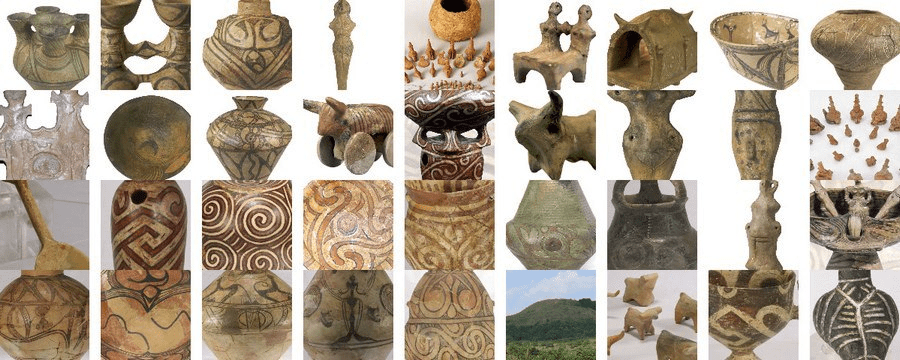
Trypillya people developed villages with long, rectangular houses that were sometimes arranged in concentric circles.

This kind of construction style is also found at Kot Dijian and Mohenjo-Daro archeological remains.
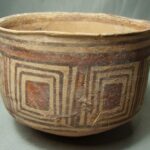
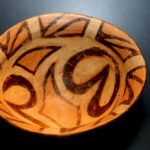
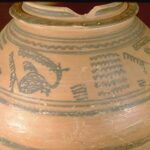
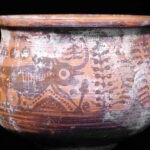
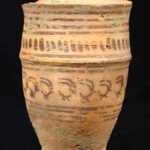
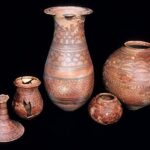
Clay work paintings and pottery paintings found in Indus Valley and Harappa Civilization are exceptionally identical with Trypillian culture. However, there is a major difference in the construction of houses of Harappan and Trypillian culture that is used for clay bricks. Harappa, Kot Dijian and Mohenjo-Daro were constructed with hard clay bricks while Trypillian culture mostly used wooden structure.
There are several similarities between Harapan culture (Sahiwal Punjab Pakistan) and Trypillian culture including their abrupt declines and extinction.
Indus Valley Civilisation had established Agriculture, had well planned and developed cities had the presence of wheel, used clay pottery, and knew use of copper also. People of Indus Valley Civilisation, lived a luxury lifestyle (beautiful crookery, jewelry) and knew the use of cotton for fabrics and clothing.
Trypillian culture also knew agriculture techniques, production of refining pottery, clay work, processing of copper, usage of luxury items like decorated dishes and utensils and use of the wheel.
By the way, according to archaeological data, Trypillian villages lived in 15-17 families. Such kind of units are also found at the archeological sites of Harappa and Mohenjo-Daro.
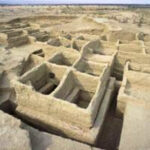

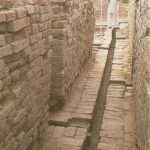
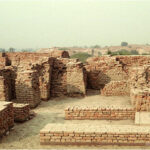
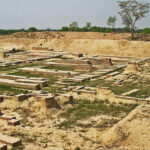
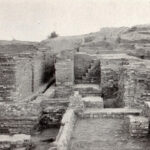
Trypillian houses were divided into partitions, and living rooms had windows. The same style of separate rooms can be seen at Harappa and Mohenjo-Daro archeological remains.
According to some theories (Marija Gimbutas, the book “Notes on the chronology and expansion of the Pit-Grave Culture”), the Cucuteni–Trypillia culture was destroyed by force because people of Trypillia culture were peaceful agriculturalists and could not bear a series of attacks from foreigner barbaric tribes. Historians believe that invaders permanently destroyed Cucuteni–Trypillia culture around 3000–2800 BC.
If we talk about Harappa and Mohenjo-Daro, historians also cite similar theories as for Cucuteni–Trypillia culture.
Historians believe that Aryan or any foreign force killed people and destroyed the Indus Valley Civilization. The Harappa people were peace-loving and of agrarian nature. They did not have weapons to attack others or to defend themselves. They were simple farmers, not fighters therefore they could not defend themselves against the invaders. The destruction of these people by Aryans or any other foreign force was a sad event in history but even foreign invaders did not live for long in Harappa and Mohenjo-Daro because Aryans (or any foreign invaders) knew nothing about agriculture and urban life and could not manage to deal with changing river patterns. These changes in river patterns included the drying up of the Hakra River and changes in the course of the Indus River. The river changes disrupted agricultural and economic systems, and many invaders left the cities soon and Indus Valley Civilisation could not survive.
By 1700 B.C., the Indus civilization had gradually broken up into smaller cultures, called late Harappan cultures and post-Harappan cultures. However, some aspects of Indus art, agriculture, and possibly social organization continued in smaller cultures. Some of these aspects became incorporated into a unified urban civilization that began developing throughout the region about 600 B.C.
The Indus Valley and Cucuteni–Trypillia cultures gave to the world earliest cities, town planning, architecture in stone and clay, and agriculture techniques.
There is a dire need for further research and exploration of linkages between golden civilisations of Indus Valley and several of pre-historic European civilisations and connect missing dots between modern Europe and modern Pakistan.
